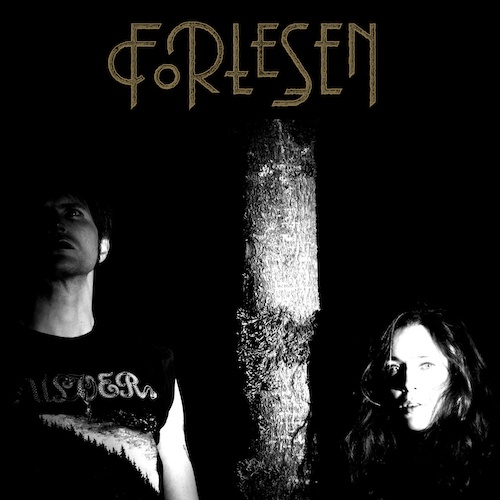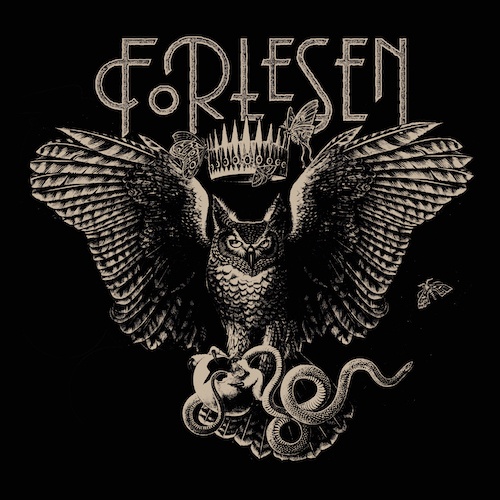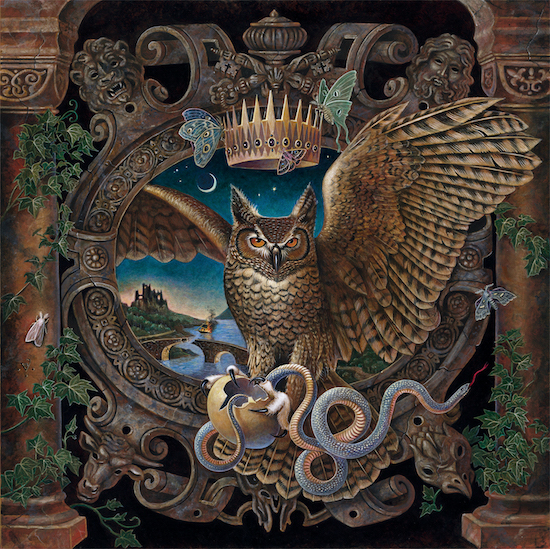
(Comrade Aleks has brought us a new interview, and an especially interesting discussion it is, with Ascalaphus, one of the participants in Forlesen.)
Forlesen is the product of a spiritual and musical collaboration between Ascalaphus (vocals, guitars, synth, harmonium), Bezaelith (vocals, guitars, bass, synth) and Maleus (drums). I believe NCS readers know well Ascalaphus and Bezaelith due to their practices in Botanist and maybe Lotus Thief, and Maleus originally performed his duties in avant-garde outfits Kayo Dot, Vesper Moth, and Maudlin of the Well.
The interaction between these three artists turned into Forlesen’s first album Hierophant Violent, released by Hypnotic Dirge about a month ago. The band’s material is woven of psychedelic sonic filaments made from doom, ambient, and black metal – a blend which may surprise even Botanist’s followers. The album consists of just of two long tracks, but these tracks are worthy of listening, just as this exciting interview with Ascalaphus is worthy of reading.
Salute Ascalaphus! What’s going on in Forlesen’s camp nowadays? How does the whole situation with the quarantine inflict on the band’s activity?
Infernal hails (with a chance of rain) – Forlesen is roughly as active as it’s ever been right now, perhaps more so. The first album was created when we all lived in the Bay Area – but even then, we mostly wrote in isolation. We’d meet up and go over things in person, but much of the work was done individually at first. These days, we actually all live in different states, but particularly in light of quarantine, it changes very little. We talk on the phone and do video chats the same as we do with people who live in the same city as us. So despite the obvious stresses quarantine provides, it generally means plenty of time to be working on new material.
Does your method of work at a distance imply that each of the band’s members play equal roles in the songwriting process? I can’t imagine how a song like yours could be started this way… You know, it’s not a riff-based thing with a solid structure, for example…
That’s something that shifts and I suspect may continue to. If there’s one person at the helm of this project it would be me, but we work together because we trust each other to help create something larger than ourselves. There are parts on this first album that I wrote the foundation of, and other parts that Bezaelith did, but we still layered on top of each other in ways that often completely transformed the initial idea. Maleus joined after Hierophant Violent had been “written,” but what he brought to things made the album so much better. For music with this much texture, I think even tailoring the mix is an act of composition.

I call Forlesen a band, but how do you see it from inside? Is it a really complete band from your point of view or a temporary collaboration, a project to which you can return whenever you feel it’s needed?
Forlesen is indeed a band and not a side project, not that the two are mutually exclusive. It is temporary in the same sense that all nouns are – everything ends – but it is a living entity unto itself with an energy that continues to reveal itself the more it’s explored.
The band consists of three personalities with different musical backgrounds, even you and Bezaelith have your own bands besides the commonly known ones like Botanist and Lotus Thief. What united the three of you under Forlesen’s banner?
Bezaelith and I worked together in Botanist, but neither of us has been involved in that project for several years at this point. We’re both on The Shape of He To Come and were part of the live line-up prior to the release of that album, I for a bit longer than she. Somewhat concurrently with that, she had started Lotus Thief. I’d been interested in doing another project with her for a while, and, eventually, the timing lined up.
While I’d been in Botanist, we did a European tour with Kayo Dot. I reached out to their drummer from that Coffins on Io period about doing session work but he lived in NYC and was no longer drumming for the most part. He put us in touch with Maleus, who actually lived in the Bay Area where we both were, and he’d played on Choirs of The Eye, which was a significantly formative album for me. He liked what we were doing and we liked working with him, so he became a full-fledged member of the band.
How was musical form of Forlesen born? Which basic ideas did you reveal to Bezaelith and Maleus when inviting them into the band?
Bezaelith had been – and still is – pretty busy with Lotus Thief (to which, these days, I am also a contributor). She’s a good friend and a hell of a musician. I’d been wanting to get a new project going for a bit, and had hoped we might work together again with something more personally meaningful than Botanist. One November night, when having drinks together amidst a fair amount of heavy shit going on in our respective lives, she indicated that she’d be interested in working on something “darker and more minimal” than anything she’d done before. I think she had a good sense of my musical inclinations already, but we talked about a lot of different reference points, among them dark ambient music – she mentioned being a fan of Desiderii Marginis. I’d been listening to Cold Meat Industry stuff since back in the ’90s, so that’s pretty formative for me. We also both love soundtrack music like Wendy Carlos. I went home and began experimenting with creating something in line with what we discussed that ended up being the seed that became “Following Light”. Soon she was sending stuff back that added to it, and the music took on a momentum of its own, though that’s certainly been interspersed with gestation periods. Maleus came in after we already had a draft of the first album completed, but I think his contribution still really shaped what the album became. He’s been involved earlier in the process moving forward.
Forlesen – Nightbridge
I was searching and the only hint I’ve found on the origin of the band’s name is Gene Wolfe’s book Labor Day: Forlesen. Am I right with my suggestion and is the band’s spirit partly connected with this book?
I only became aware of this story semi-recently and I haven’t read it yet, so I can’t speak to whether there’s any spiritual connection or not, but if there is, it’s coincidental/synchronous. I’m not sure of the context it’s used in that story, but Forlesen is also a Middle English word meaning “to lose completely”. It felt apt to where we wanted to go sonically and thematically.
The press sheet points out that Hierophant Violent was conceived during a time of immense personal loss. Do you feel you’ll be able to continue to keep Forlesen growing beyond this concept?
I would hope so. While I don’t feel confined to make Forlesen explicitly “about loss,” I think the name etches an identity and reverberates with a particular current. Because the nature of our experience of existence is ephemeral, loss is a constant – this isn’t pessimism, just a recognition of a universal truth, the same as recognizing that death is a part of life. To acknowledge this isn’t wallowing or a negation of life, but an integration of what some might otherwise avoid. So, whatever is going on in our respective lives, including joy and fulfillment, a meditation on loss isn’t contradictory to it. And, let’s be honest…look around. I heard a quote attributed to Townes Van Zandt, though I’ve not been able to verify it…”There are two kinds of music, the blues and zippity-doo-da. And zippity-doo-da scares the shit out of me.”
There are two multi-layered, deep compositions on Hierophant Violent. How did you work on these tracks? How many ideas did you put aside, considering the tracks’ complexity? When did you decide that the work was done and there was nothing more to add to this material?
The writing process was almost surprisingly organic. Here and there we might have left out or altered an idea to make it better, but by my experience, it felt like the songs revealed themselves and we simply showed up to do the work, which isn’t to say it isn’t consuming to be involved in its creation. But the very first ideas we had for the project are contained within the album. We knew we wanted to make each song roughly 18 minutes, as this is the ideal length for a side of vinyl at maximum fidelity and we wanted it to feel like 2 sides of an album – and we had certain reference points in mind sonically and emotionally. Sometimes, things revealed themselves in surprising ways, a part growing into something we would barely have recognized when we first started it and it felt like we could hardly have planned for…following the Muses.

Hierophant Violent’s artwork is symbolic and full of its own life despite images of a ruined castle, a burning ship, and a devastated bridge in its background. How did you work with Benjamin A. Vierling on this cover?
I can’t claim to know how Benjamin accomplishes his work other than to say that he is clearly deeply inspired. That said, he asked us what we had in mind and we talked with him a fair amount about the ideas behind the album and imagery that felt appropriate. Between that and clearly having spent time with the album, he came up with the album cover. We couldn’t be more pleased.
The songs’ lyrics are poetic and vast, and the vocals join into a single stream of mournful tunes that you perform through both ‘Following Light’ and ‘Nightbridge’. Do you feel a necessity to channel your message carefully through texts as well as through music? Do you feel a necessity to make your listeners feel the same vibe?
Thank you. If the question is “are lyrics important?” the answer is yes, but in this case, more for a purpose of evocation than instruction. I know what was going on in our respective lives when certain lines were written, but to say that the songs are “about” that isn’t really accurate. They were inspired from there in part, but it’s also somewhat like a dream or a movie that’s open to different interpretations. I can’t know what someone else feels or associates when they hear the music or read the words, and while I suspect I know the color of it, the meaning is theirs to ascribe.
There’s a video for one of the album’s songs, ‘Nightbridge’. It’s a strong, abstract, and expressive piece. Do you see visualization as an important act of development for the entire Forlesen concept?
I think the music feels like its own world – something you can walk around in within your mind’s eye. I feel like it’s visual music in the sense that it has a cinematic and psychedelic quality to it. This doesn’t necessarily have to be realized in music video form, but I’d thought it would be interesting to have a video for the album and, synchronously, Hypnotic Dirge suggested having one made without my asking. As far as the video for ‘Nightbridge’ is concerned, the director spoke with me about what he envisioned based upon hearing the music and the feeling he got from it and I thought it was a cool idea.
Yes, it seems to be simple, but it’s emotionally very strong, it’s consonant to the song. Forlesen’s sound stands on ambient, doom metal, and psychedelic, and it has traces of black metal at the same time. How natural was the way of keeping the balance between these elements? Did you feel an urge to put one of them before others?
This is the music we wanted to make. While I love and worship at the altar of music that feels like it just purely embodies the spirit of a particular genre – as, for instance, Funeral Mist is to Black Metal – and I do think it’s important that if you’re drawing from Black Metal, you actually comprehend both the “Black” and “Metal” parts of it, I feel like what we wanted to express is a current that shows itself in a lot of different music that there’s actually plenty of overlap to if you’re listening.
We knew when we started this project that we were thinking “dark and minimal”. Whether or not it has transcended that is up to the listener to decide, but that covers a lot of sonic territory. To me, Low and Pink Floyd are absolutely relevant to doom and are so much fucking heavier than 98% of so called heavy music. Or the way Mount Eerie drew from Black Metal… why shouldn’t it go back the other way? How much more harrowing is “A Crow Looked At Me” than most allegedly bleak metal, without any of the fucking pretense? While I’m not seeking originality just for its own sake, I think most interesting art is doing something at least somewhat “new” – if it doesn’t feel at least slightly fresh, then it seems kind of defeatist… and what “new” often really means is doing something that’s been done before, but changing the context.
True to tell, I didn’t think about this question from this angle, and it sounds truly inspiring. Do you suppose it’s possible to develop Forlesen this, way keeping the essence you embodied through Hierophant Violent?
While I think Hierophant Violent has a distinct personality that gives a sense of what the feel of the band is, the pieces clearly differ from each other and contain a breadth which, while maintaining thematic continuity, walks a line that ideally feels both surprising and inevitable. That is to say, I don’t think on first listen that what you hear 5 minutes into side one will lead you to guess what minute 13 on side two will be. If this is indeed the same essence present throughout, which I think it is, then yes, I think that it shall remain as the band evolves, but this is by definition not static. Moving forward, I imagine there will be things that feel both familiar and surprising both in atmosphere and execution.
How do you think of the prospects of Forlesen today? Will you be able to pay it the attention that the band deserves? Do you have new material already?
Yes, a second album is fully written and is in the midst of being recorded. I won’t say too much at this point, particularly because it’s still in a process of revealing itself, but it’s 4 songs and closer to an hour in length and is bringing another musician into the fold as well.
I wonder if you’re going to perform live with Forlesen. Do you have such plans?
We actually had a concert lined up a few months out that we were going to reveal closer to its actual date, but that isn’t happening now due to the current pandemic. I’d very much like to get to realize this live should the world return to a place where concerts happen again, but there are a lot of logistical considerations so the circumstances would need to be right.
Let’s keep it in secrecy ’til the time is right then. Ascalaphus, thank you for this interview. It was exciting to discover some some of the elements in Forlesen’s alchemy. I hope we’ll have a chance to taste the new album soon, but for now it’s good to have Hierophant Violent – to experience it and to absorb it.
Thank you! To anyone interested in really hearing the detail of the music, downloading the HD WAV version of the album is worth it – with headphones or a decent sound system – the difference between this and how the album sounds on Spotify is actually significant, and it’s “pay what you choose” through Hypnotic Dirge’s Bandcamp page. Love The Adversary.
https://hypnoticdirgerecords.bandcamp.com/album/hierophant-violent
https://www.facebook.com/Forlesen-515435575575427
